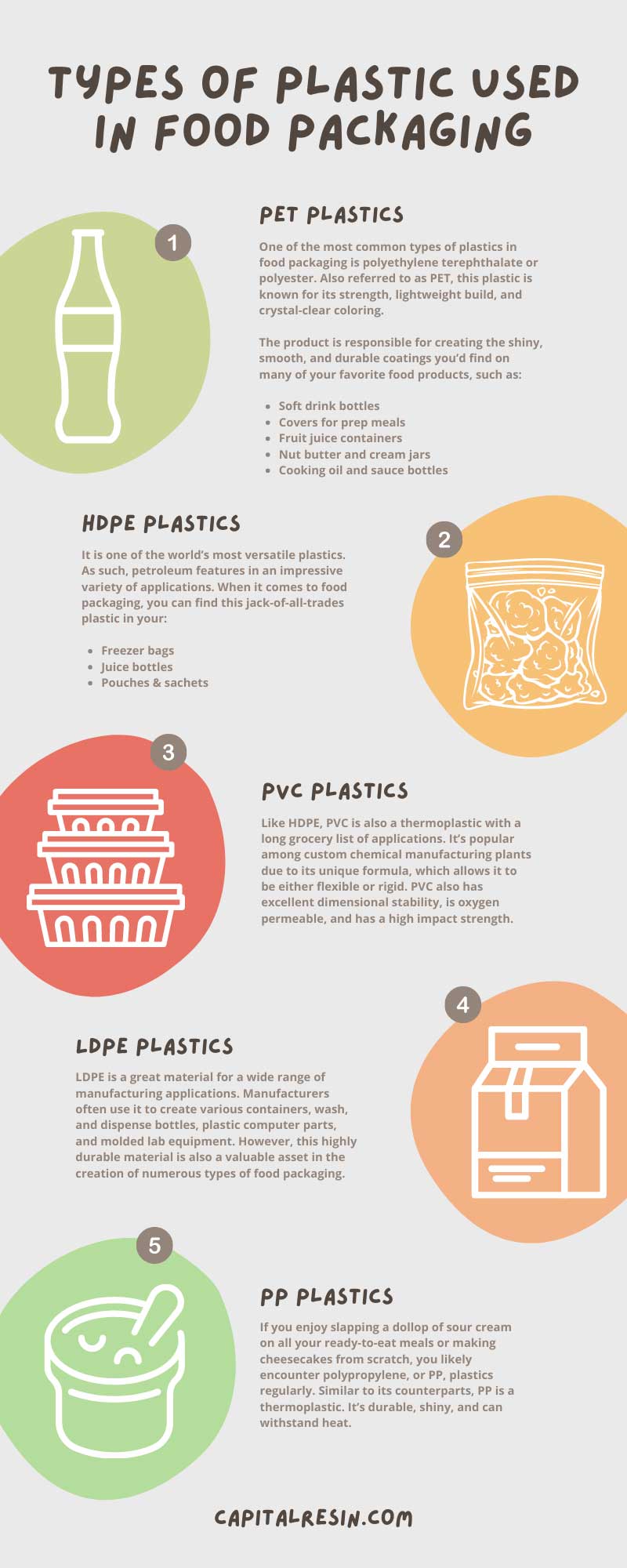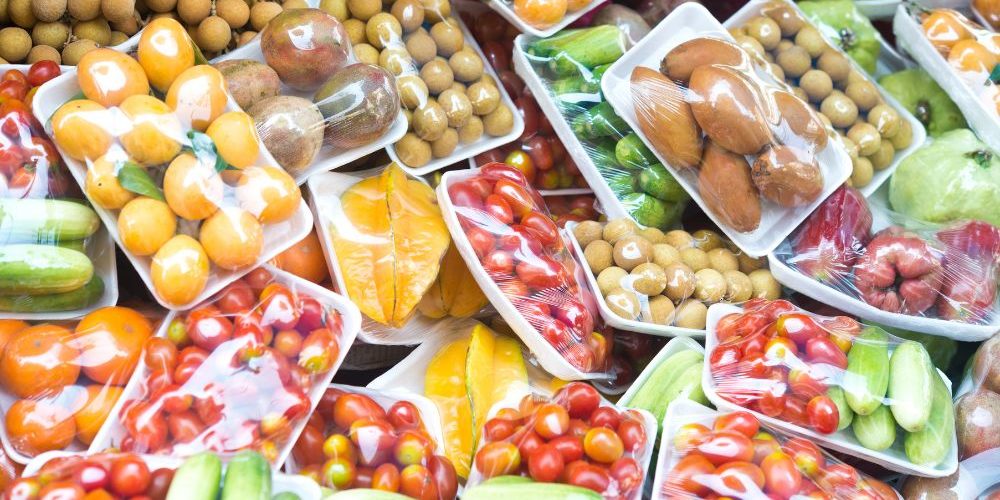All of us interact with plastics, whether you’re cracking open a fresh bag of potato chips or diving into a crisply wrapped bushel of homemade chocolate chip cookies. Manufacturers use plastics to package each neatly wrapped food item, and it’s common to see food packaged in plastic on store shelves everywhere. This is a wonderful thing!
After all, plastics ensure fresh ingredients stay well-preserved. They also protect our favorite products from contamination. Explore some of the different types of plastics commonly used in food packaging and coatings. Moreover, discover just how prominent these plastics are in our daily lives.
#1. PET Plastics
One of the most common types of plastic packaging for food is polyethylene terephthalate or polyester. Also referred to as PET, this plastic is known for its strength, lightweight build, and crystal-clear coloring.
The product is responsible for creating the shiny, smooth, and durable packaging coatings you’d find on many of your favorite food products, such as:
- Soft drink bottles
- Covers for prep meals
- Fruit juice containers
- Nut butter and cream jars
- Cooking oil and sauce bottles
Manufacturers easily mold PET into containers like sauce bottles, peanut butter jars, and the soft drink bottles that many of us would find in our pantries or kitchens.
#2. HDPE Plastics
If you’ve ever enjoyed a carton of ice cream or a splash of milk in your morning coffee, you’ve likely encountered high-density polyethylene plastics. On a chemical level, HDPE is a thermoplastic polymer comprised of petroleum.
It is one of the world’s most versatile plastics. As such, petroleum features in an impressive variety of applications. When it comes to food packaging, you can find this jack-of-all-trades plastic in your:
- Freezer bags
- Juice bottles
- Pouches & sachets
You can also find HDPE in products like water bottles, margarine and butter tubs, and box liners. Its high impact resistance and melting point are part of what make HDPE plastics so popular.
If that wasn’t enough, the durable plastic’s reputation for tensile strength and impressive density-to-strength ratio also contribute to the material’s incredible usability and longevity.
#3. PVC Plastics
You can find this next plastic near all your favorite goodies. Whether it’s fresh cookies from the school bake sale, those beautifully arranged brownies on your mom’s prized treat tray, or a jar of homemade raspberry preserves, polyvinyl chloride, or PVC, is probably close by.
Like HDPE, PVC is also a thermoplastic with a long grocery list of applications. It’s popular among custom chemical manufacturing plants due to its unique formula, which allows it to be either flexible or rigid. PVC also has excellent dimensional stability, is oxygen permeable, and has a high impact strength.
Further, this plastic acts as an effective barrier to grease and oil. Perhaps this characteristic makes PVC an ideal choice for food products like tubing for beverage systems, blister packaging for gum, seals on metal lids, food foils, and cling wraps.
#4. LDPE Plastics
Low-density polyethylene is another plastic found in a variety of food packaging. Casually referred to as LDPE, this material is a thermoplastic. Its formula comprises a compound called ethylene monomer. Its chemical makeup makes LDPE:
- Translucent
- Flexible
- Durable
LDPE is a great material for a wide range of manufacturing applications. Manufacturers often use it to create various containers, wash, and dispense bottles, plastic computer parts, and molded lab equipment. However, this highly durable material is also a valuable asset in the creation of numerous types of food packaging materials.
Some of these products include:
- Squeeze bottles
- Cling and shrink wraps
- Pouches and plastic fruit cups
You can also find LDPE in bread and frozen foods packaging and flexible lids. In short, it’s a very versatile plastic that you can use for various purposes.
#5. PP Plastics
If you enjoy slapping a dollop of sour cream on all your ready-to-eat meals or making cheesecakes from scratch, you likely encounter polypropylene, or PP, plastics regularly. Similar to its counterparts, PP is a thermoplastic. It’s durable, shiny, and can withstand heat.
Chemically, PP is an addition polymer created through a combination of propylene monomers. Regarding food packaging, PP is in your sour cream and cream cheese tubs. You might also find it in your yogurt packets. You can thank PP plastics for keeping your food fresh with those vacuum-sealed skins.
It’s also a popular choice for the durable and convenient chip bags we love to stock our pantries with. With that said, this plastic rose to fame for its role in microwaveable plastics. Its ability to withstand harsher temperatures comes from its impressively high melting point.
#6. PS Plastics
Backyard BBQs, restaurant kitchens, and grocery stores have a purpose for polystyrene, or PS, plastics. Whether you’re drinking from a red plastic cup with your pals or packing to-go orders at your restaurant job, PS plastics are everywhere.
Like most of the other plastics mentioned in this guide, PS is a thermoplastic. It’s naturally transparent and can come in solid form or as a rigid foam material (think Styrofoam cups). PS is ideal for a variety of commercial purposes, so the list of food packaging that uses the plastic is extensive.
Here are a few of the PS products you might be familiar with:
- Disposable food containers (to-go boxes, cups, hinged takeout containers)
- Meat and poultry packaging or rigid food containers (grocery and restaurant meat containers)
- Food service containers (to-go coffee cups, plastic plates, and bowls, disposable cutlery)
- Egg cartons, medicine, and vitamin bottles
And the list goes on and on. Basically, PS is another commonly used plastic you’d find in most of your food packaging and containers.
#7. Other Plastics
There are other types of lesser-known food-safe plastics like the polycarbonate plastic Nalgene. These plastics are super hard and durable, making them the perfect ingredient for products like baby bottles and cooler jugs.
There are also cutting-edge plastic materials like polylactic acid or PLA, which derives from organic, renewable matter like sugar cane and cornstarch. You can find these plastic components in biodegradable and eco-friendly versions of products like straws, to-go packages, plates, and bowls.
In short, you will likely interact with at least one of these plastics, whether you’re eating an entire tub of ice cream, feeding your baby, or drinking an extra dry cappuccino from your favorite coffee house. Each plays a role in creating the food packaging that houses our most beloved snacks, beverages, and meals.
If you’re looking for a supplier for your food packaging needs, feel free to contact Capital Resin today.


